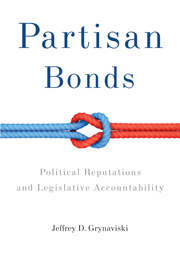6 - Brand Names and Party Strategy
Published online by Cambridge University Press: 05 May 2010
Summary
One of the central themes in previous chapters of this book was that the Democrats and Republicans in Congress are able to maintain their brand names through a combination of agenda control by the majority party and a system of reward payments to party members who toe the party line. It was asserted that one reason that party elites favor these kinds of institutions is that they value the appearance of party unity because it is a necessary condition to maintain their brand name. However, previous researchers have argued that party elites agree to the establishment of institutions that secure some level of party discipline in government because they value belonging to a legislative team that secures partisan logrolls which are mutually beneficial to all organization members, and partisan institutions prevent individual legislators from free-riding on this collective good when it is in their short-run self-interest to do so (cf. Schwartz 1977). The motivations identified in previous research for forming institutions to enforce these logrolls are that party members value the policy achievements as desirable ends in and of themselves (e.g., Aldrich 1995; Rohde 1991) or as a means to further their electoral interests through credit-claiming back home (e.g., Kiewiet and McCubbins 1991; Cox and McCubbins 1993, 2005). The purpose of this chapter is to demonstrate that, in addition to enforcing partisan logrolls, an important factor shaping the choice of a party's control apparatus is the desire to convey to the public how votes for its candidates might translate into policy outcomes.
- Type
- Chapter
- Information
- Partisan BondsPolitical Reputations and Legislative Accountability, pp. 167 - 206Publisher: Cambridge University PressPrint publication year: 2010

